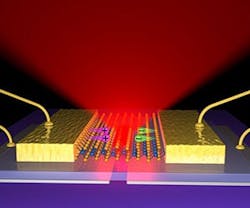Researchers Develop Tiny, Efficient LEDs
From computer monitors and digital display boards to smartphones and wearable technologies, many modern electronics utilize LEDs. As these devices get smaller and faster, there is more demand for LEDs that are smaller, stronger, and more energy efficient.
To accommodate this trend, University of Washington (UW) scientists have built the thinnest known LED that can be used as a source of light energy in electronics. The LED is based off of flexible two-dimensional semiconductors, making it possible to stack or use in more diverse applications than current technology allows.
"We are able to make the thinnest-possible LEDs, only three atoms thick yet mechanically strong. Such thin and foldable LEDs are critical for future portable and integrated electronic devices," says Xiaodong Xu, a UW assistant professor in materials science and engineering and in physics.
Most consumer electronics use three-dimensional LEDs, but these are 10 to 20 times thicker than the LEDs being developed by the UW.
"These are 10,000 times smaller than the thickness of a human hair, yet the light they emit can be seen by standard measurement equipment," says Jason Ross, a UW materials science and engineering graduate student. "This is a huge leap of miniaturization of technology, and because it's a semiconductor, you can do almost everything with it that is possible with existing, three-dimensional silicon technologies.”
Xu and Ross co-authored a paper about this technology in Nature Nanotechnology.
